Coach Position and Seat Map
Train coach position refers to the coach's order in the train, while seat position specifies your seat within the coach compartment (e.g., upper, lower, window), which you can check here. A seat layout map visually displays the arrangement of seats within a coach, aiding passengers in selecting and locating their seats.
Enter train no above to get live coach position details for your train.
Example, 12617 coach position:
- 0 LPR
- 1 GEN
- 2 GEN
- 3 2AA1
- 4 2AA2
- 5 3EM1
- 6 3EM2
- 7 3AB1
- 8 3AB2
- 9 3AB3
- 10 3AB4
- 11 SLS1
- 12 PC
- 13 SLS2
- 14 SLS3
- 15 SLS4
- 16 SLS5
- 17 SLS6
- 18 SLS7
- 19 GEN
- 20 GEN
- 21 SLRD
Mangladweep Express coach order finalization: Today 09:26
Engine reversal stations: None
12617 train seat map: second 2 tier AC (2A), sleeper coach (SL), second seater (2S), chair car (CC)
Beware misleading coach positions: Third-party sites like TrainMan, RedBus, EaseMyTrip, Rinfo and Railofy often mislead by showing train rake composition instead of live coach position. This can lead to missed trains and significant financial and emotional losses. For accurate coach position, rely exclusively on official government sources: NTES website, NTES app and train app.
Train seat position
Train seat position refers to the specific location of your seat within the coach, such as upper, middle, lower, side, window, or aisle. Your ticket, the reservation chart, and markings inside the coach help you identify your seat position. Different classes offer various seating arrangements, from berths in sleeper and AC classes to standard seats in chair cars. We can check these layouts below using the images for each coach.
Seat layout map
A train seat layout map, also sometimes referred to as a coach layout or seating chart, is a visual representation of the seating arrangement within a specific train coach. These maps are valuable resources for passengers, helping them understand the different seat types, their locations, and their arrangements in the train bogie/compartment. Irctc train seat position:
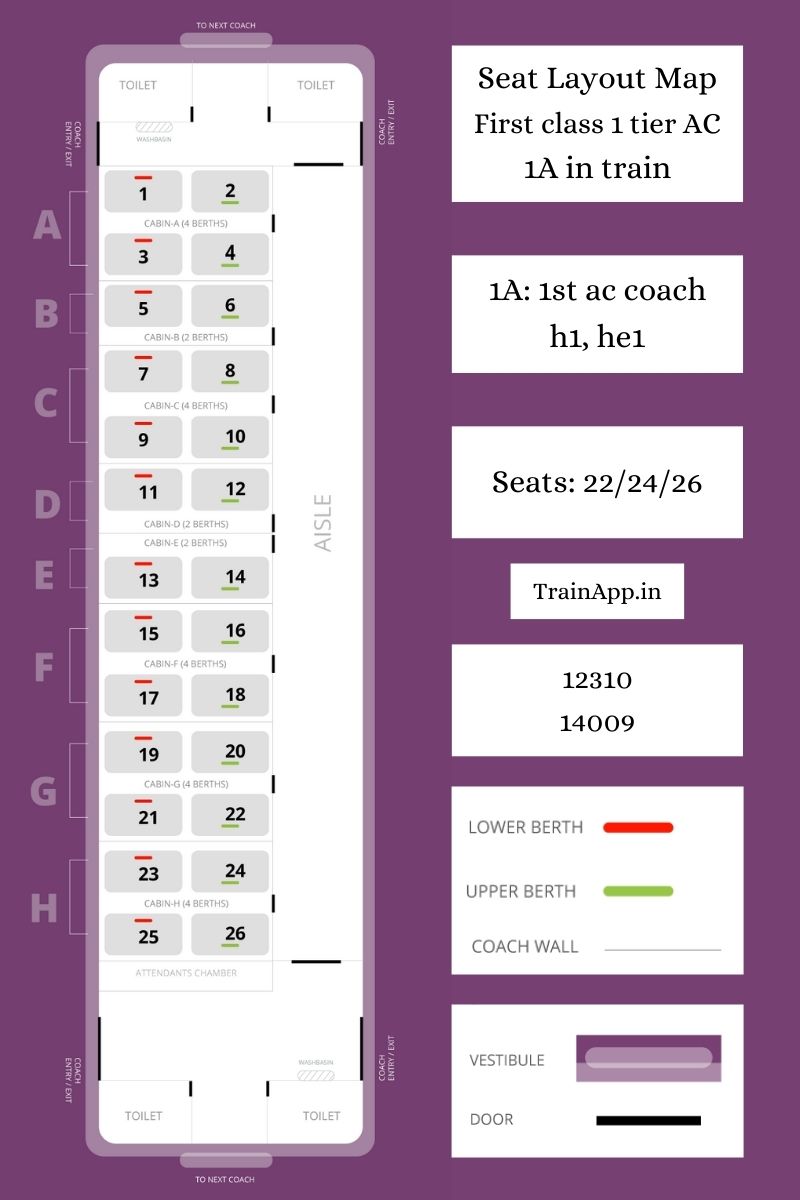
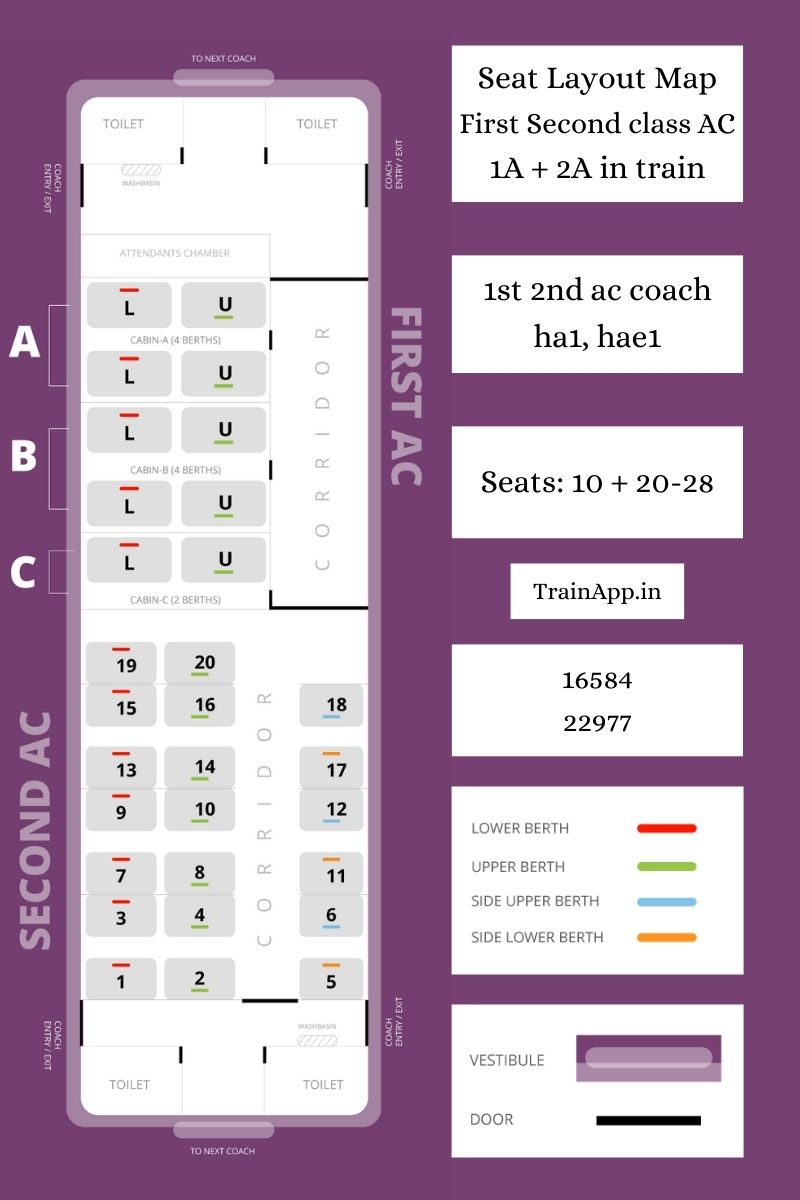
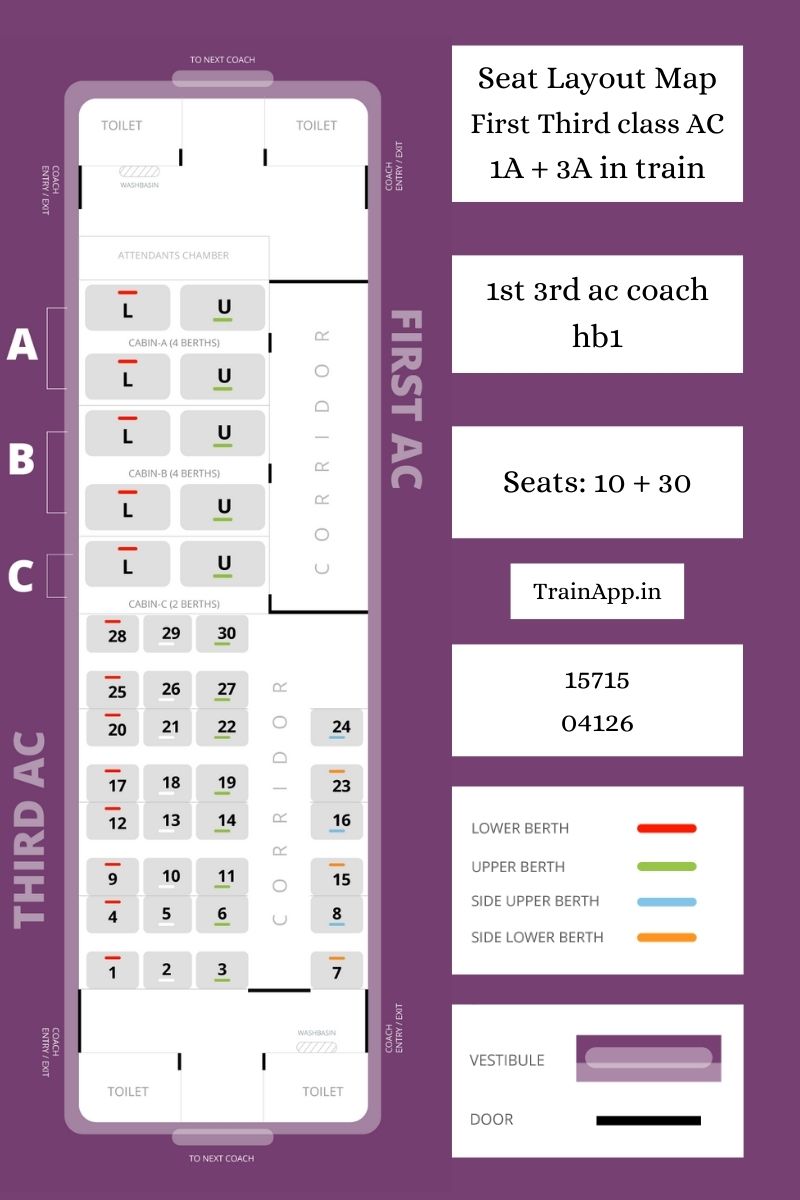
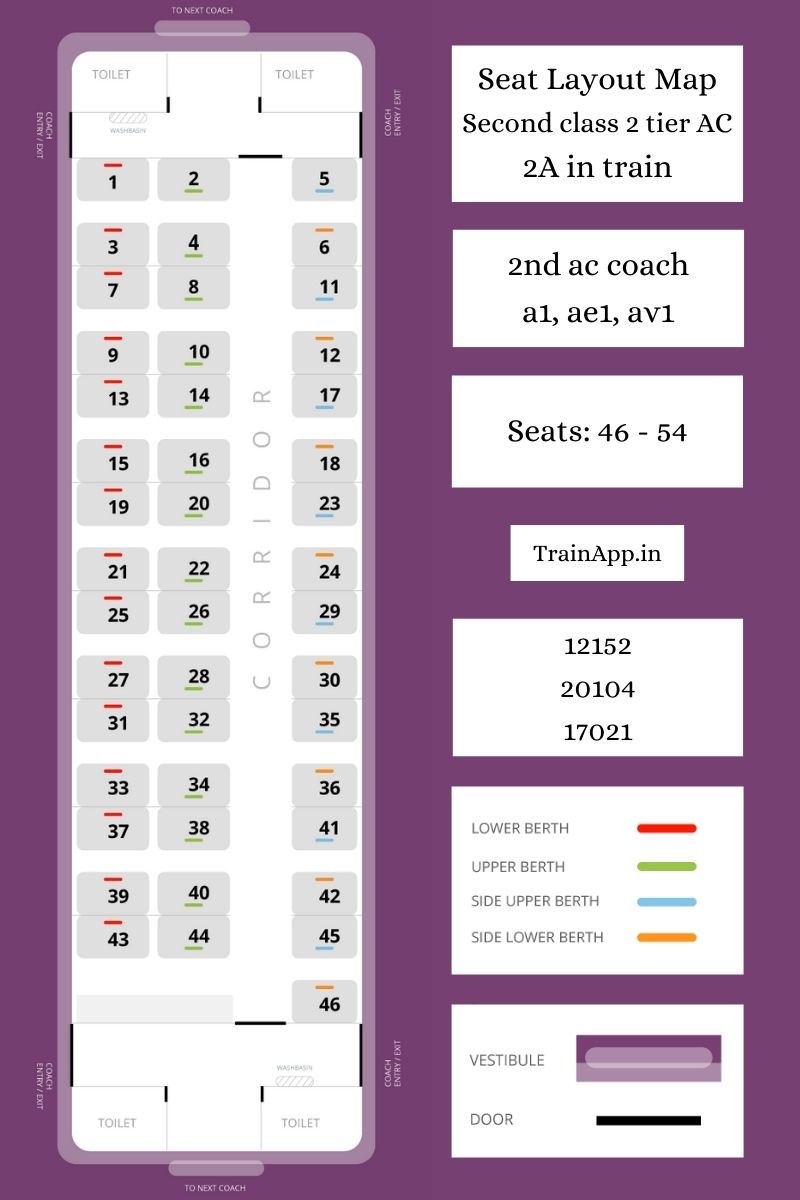
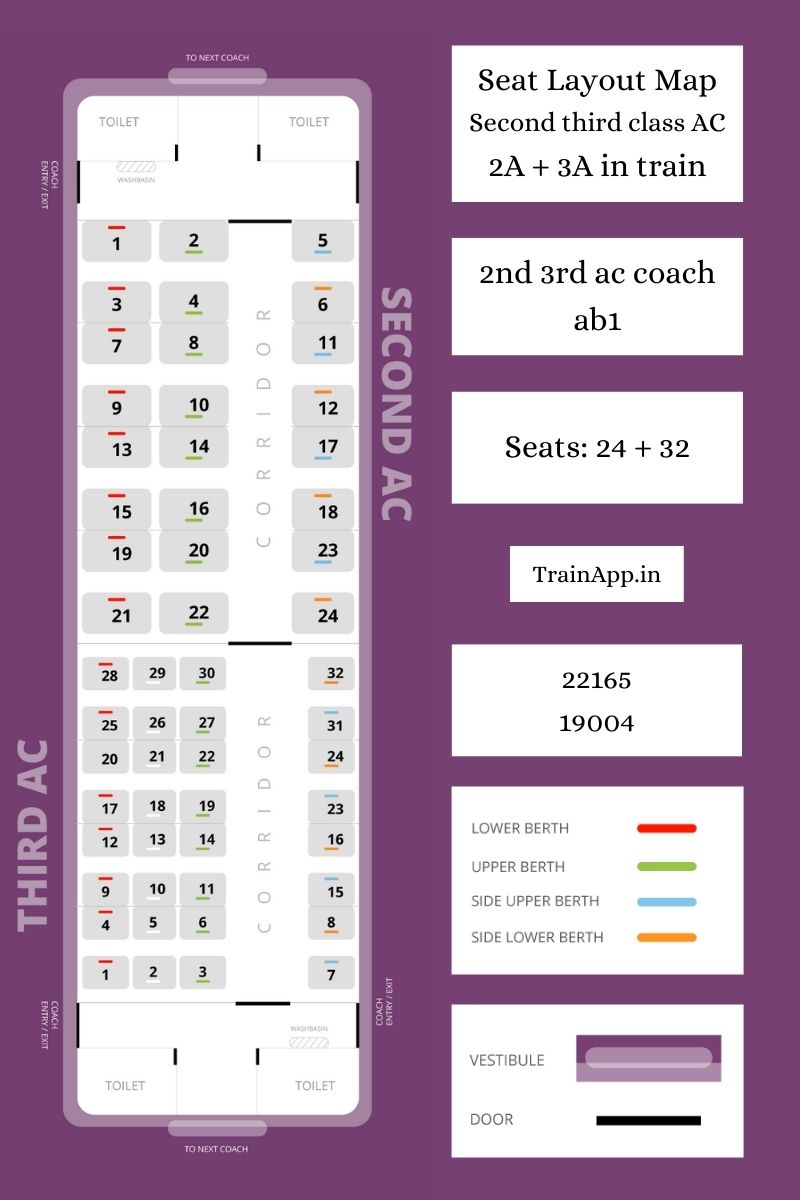
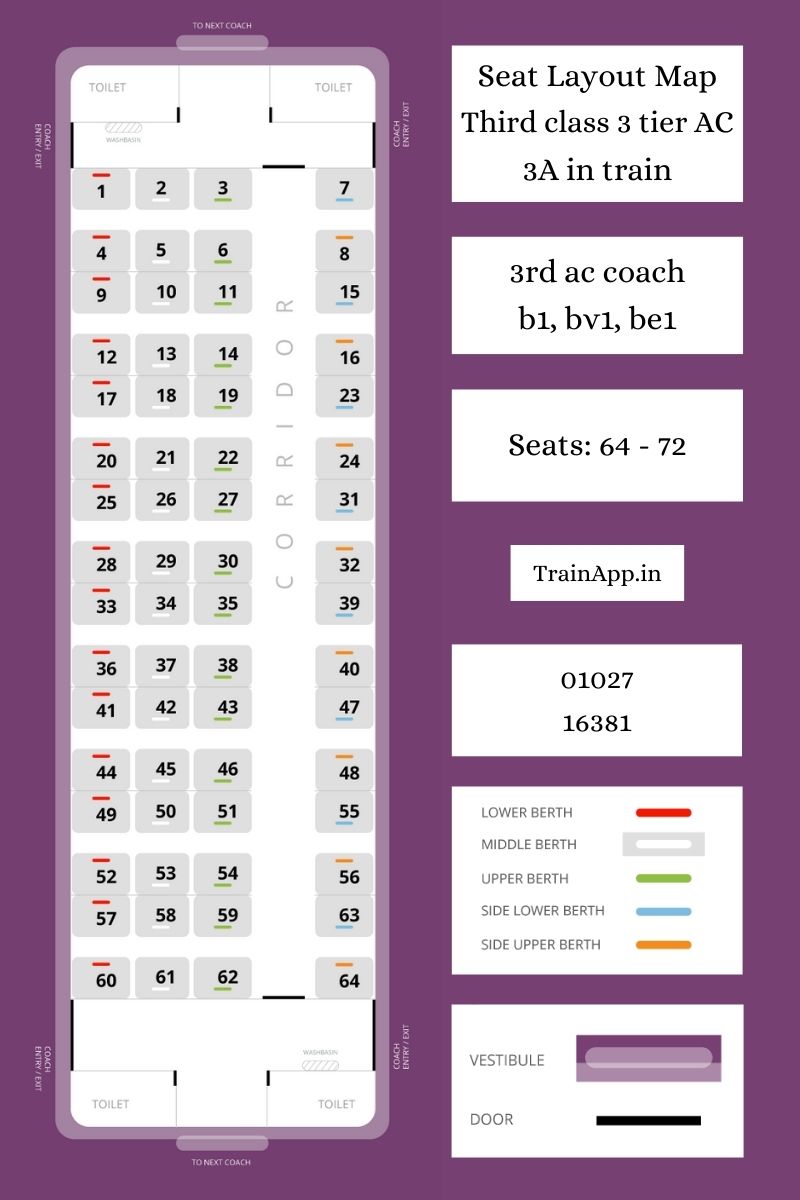
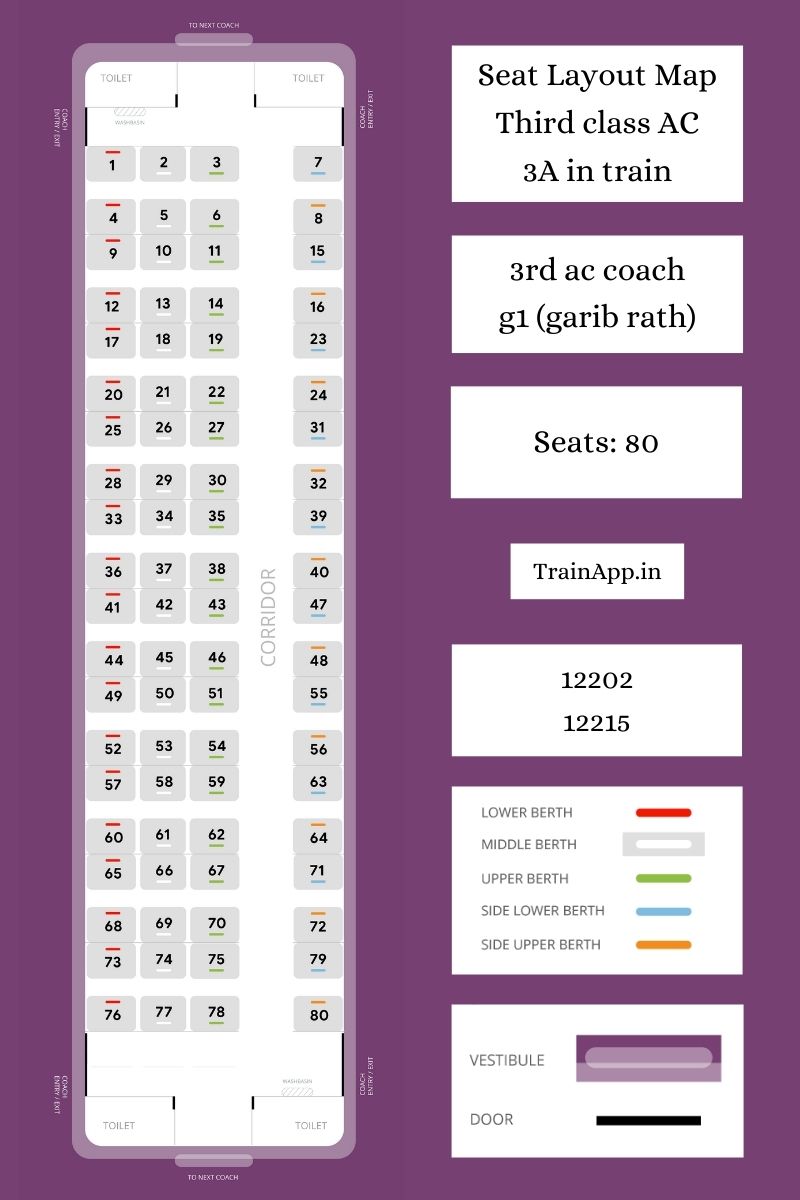
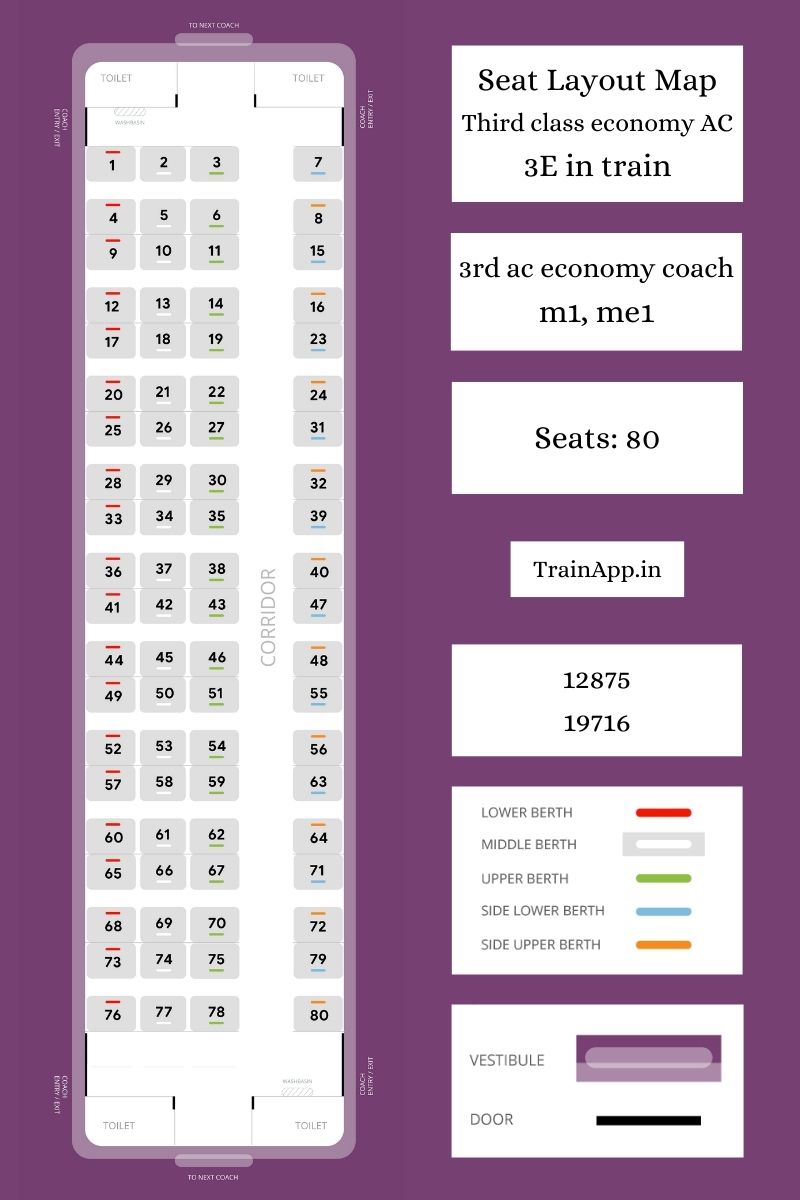
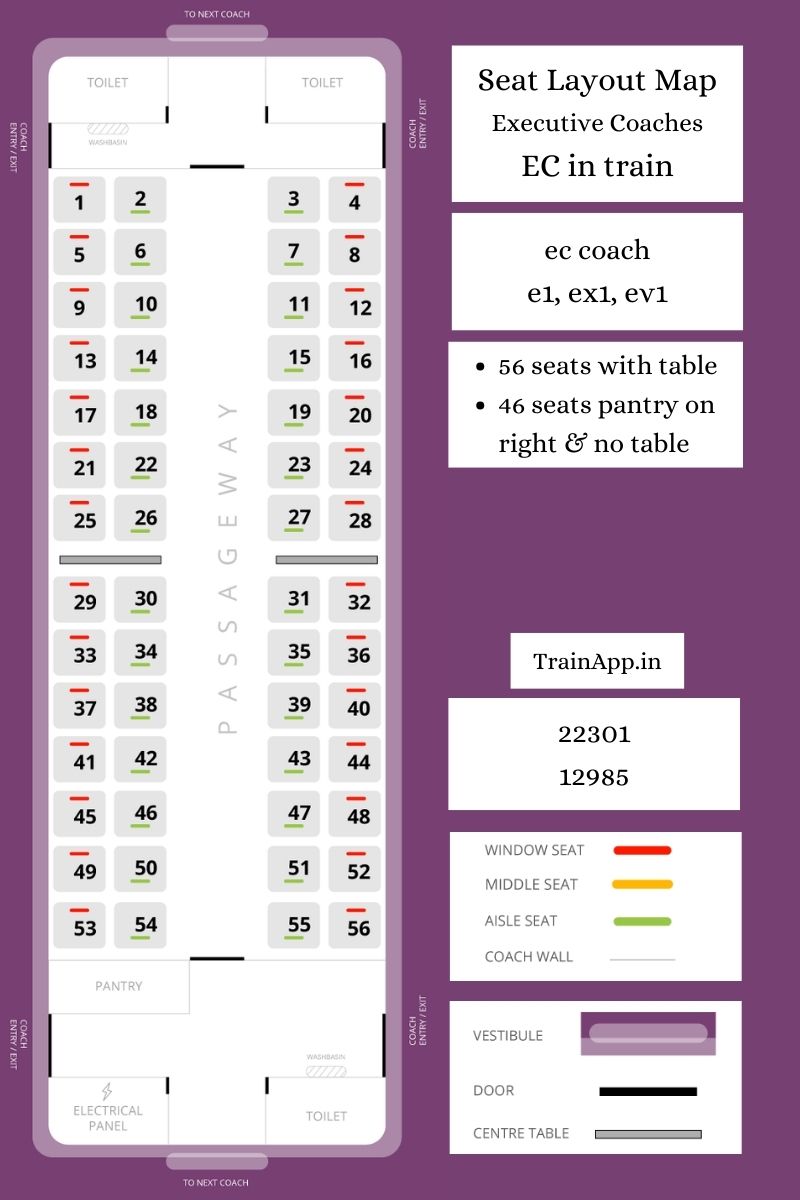
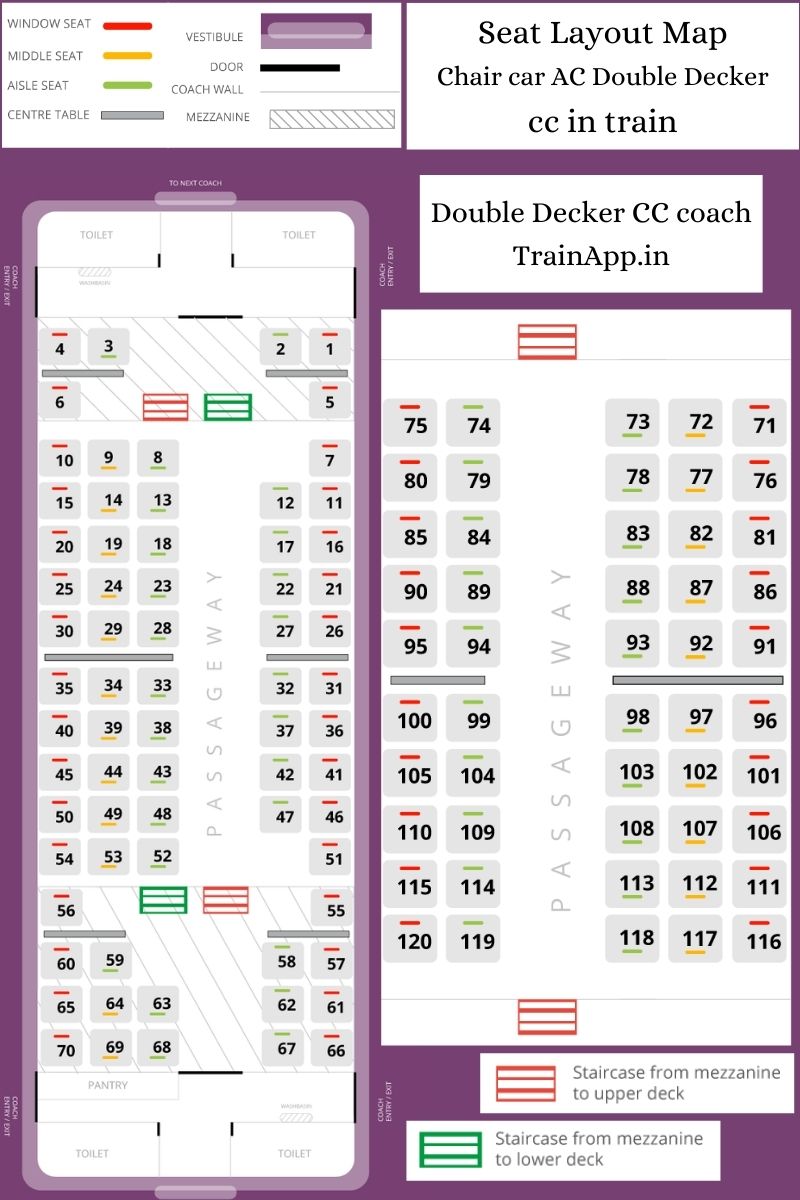
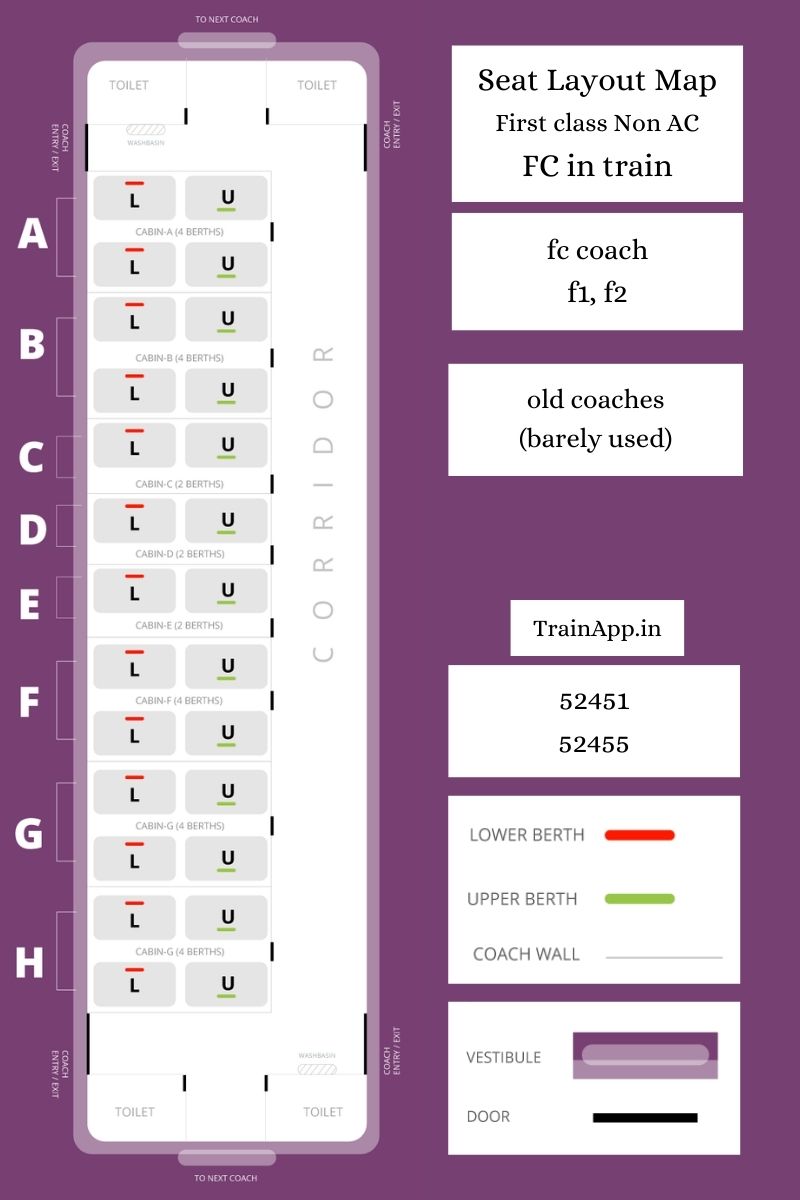
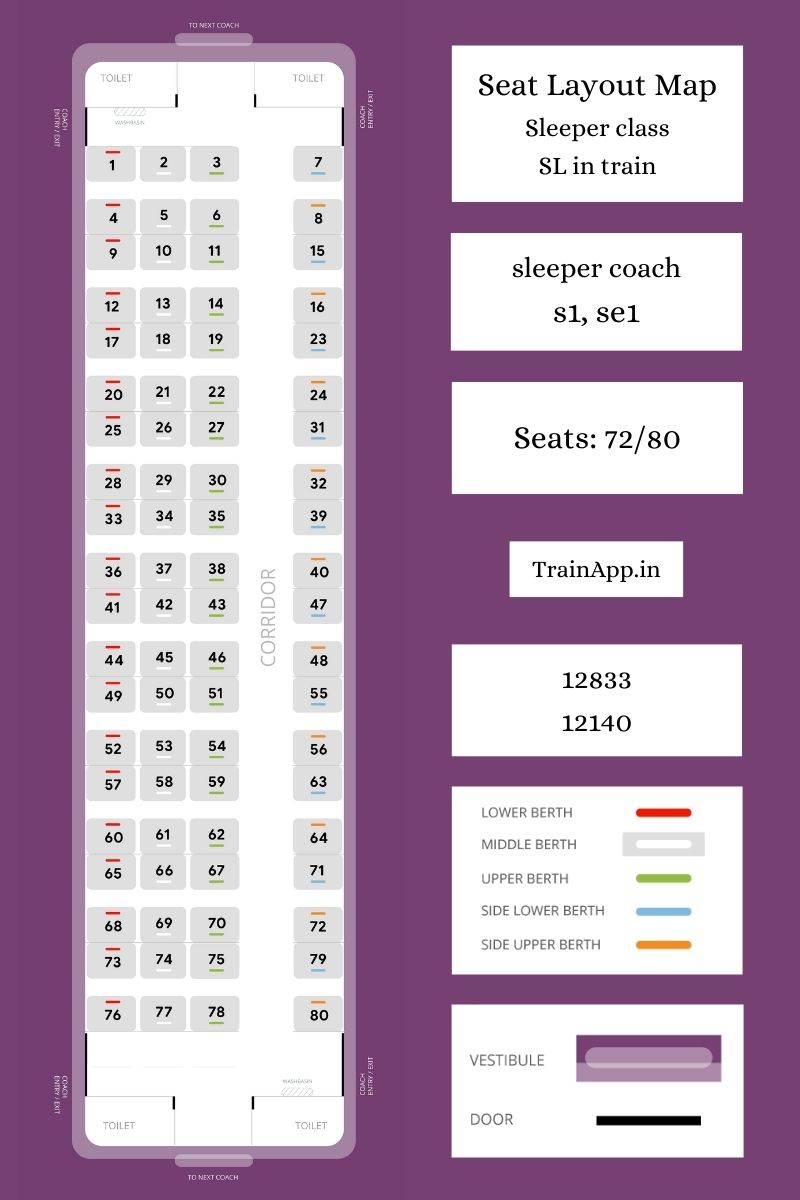
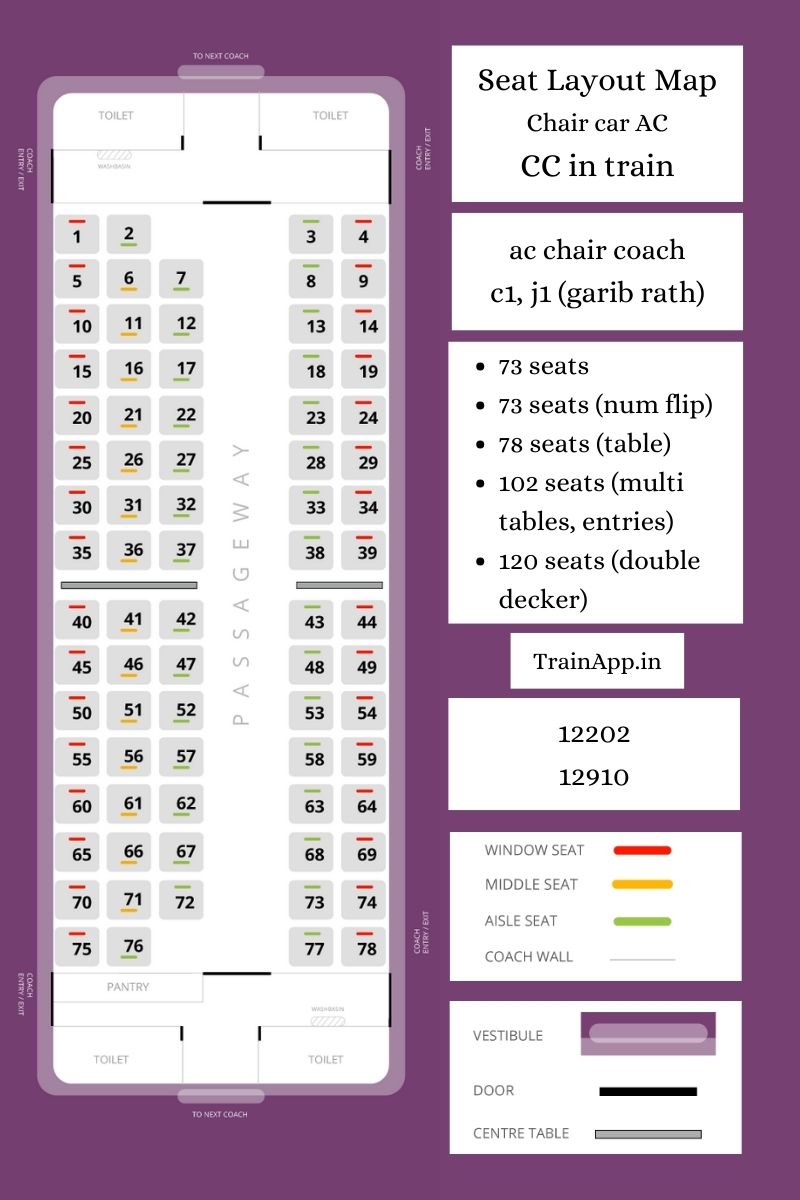
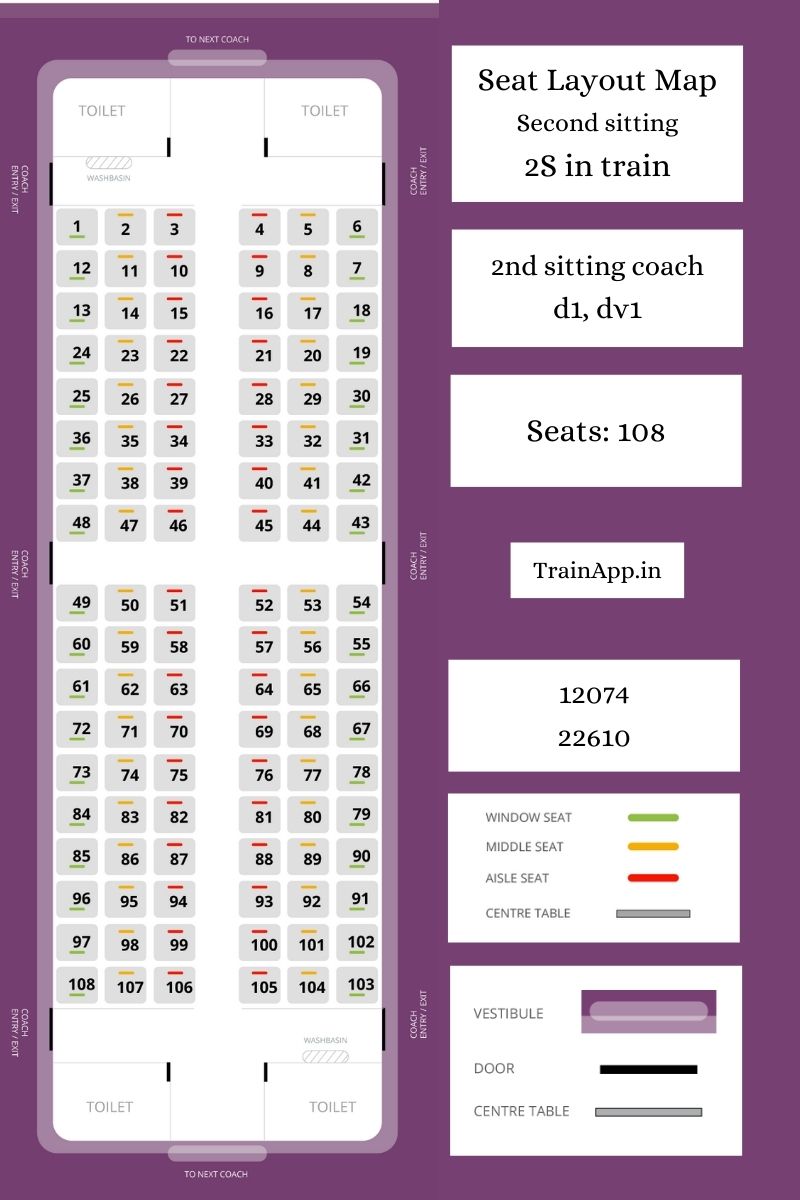
Class to coach numbering pattern:
- 1A (first class 1 tier ac): 1st ac coaches (H1, HE1, HA1, HAE1, HB1)
- 2A (second class 2 tier ac): 2nd ac coaches (A1, AE1, AV1, AB1)
- 3A (three-tier ac): 3rd ac coaches (B1, BV1, BE1, G1, b2, b3)
- 3E (three-tier ac economy): 3rd ac economy coaches (M1, ME1)
- CC (AC chair car): AC chair coaches (C1, J1, CE1, c2). Used by Intercity and Vande Bharat for WS aisle seats with NC status. Variations: with center table, pantry (67 seats), mini pantry (78 seats) left to right number reverse and Double Decker.
- EA (executive anubhuti): anubhuti coaches (K1).
- EC (executive chair car): executive coaches (E1, EV1, EX1, e2)
- SL (sleeper class): sleeper coaches (LHB: S1, s3, s4, s5; ICF: SE1)
- FC (first class): first class non-AC coaches (F1)
- 2S (second sitting): 2nd sitting coaches (D1, DV1, DL1, d2, d3)
- LHB coaches provide superior safety, more seats and comfort with anti-climbing features and higher speed capabilities, whereas ICF coaches are cost-effective with traditional design.
Berth Legend
- LB: lower berth
- MB: middle berth
- UB: upper berth
- SU: side upper
- SL: side lower
- R: side lower
- P: side upper
How many seats in train?
The number of seats in a train coach varies significantly depending on the class and configuration. Sleeper class coaches typically have between 72 and 80 berths (including side berths). AC 3-tier coaches usually accommodate around 64 to 72 berths, while AC 2-tier coaches have around 46 to 54 berths. Chair car coaches can range from 70 to 100+ seats depending on the specific type and layout. These numbers can still vary slightly based on the specific coach design and the presence of amenities like lavatories or luggage compartments.
- First AC (1A): Typically divided into cabins with 2 or 4 berths each (lower and upper). Coaches use LHB bogies for improved comfort and safety, with larger windows and enhanced suspension.
- Second AC (2A): Arranged in bays with 46 berths - 2 lower and 2 upper per bay, plus side berths. Both ICF and LHB bogies are used, but LHB offers a smoother ride.
- Third AC (3A): 64 berths in 8 bays, each with 3 tiers across and 2 longways. LHB bogies are becoming more common here for better ride quality; older trains might still have ICF bogies.
- AC Chair Car (CC): Seats in rows, usually 5 per row in a 3+2 setup. These are found in day trains like Shatabdi, using LHB bogies for comfort.
- Third AC Economy (3E): Similar to 3A but with slightly less space, found in trains like Garib Rath. Uses LHB bogies.
- Sleeper Class (SL): 72 berths in 3 tiers across and 2 longways, non-AC. Both ICF and LHB bogies are used, with LHB offering better comfort due to improved suspension.
- Second Seating (2S): Non-AC seating for short distances, arranged in a 3+2 configuration. These coaches typically run on ICF bogies, though newer ones might use LHB for enhanced travel experience.
- Executive Chair Car (EC): Found in trains like Shatabdi or Tejas Express, offering more legroom and wider seats, usually 4 per row. These use LHB bogies.
- Unreserved coach (UR/GN): GN or UR coach in a train are Unreserved/General coaches that provide the most economical, unreserved travel on Indian Railways, with first-come, first-served bench seating but is prone to crowding, especially during peak times. In most trains there are 3 to 4 coaches of them.
Train coach position
Train Coach position refers to the location of a specific coach within a train's formation/arrangement. It indicates the coach's order in relation to the engine and other coaches. It's about knowing where your coach will be when the train stops at the platform of the station and minimizes walking during onboarding. It contains position number and coach identifier (coach class & coach id).
Coach position format: [Sequence/order/position Number] [Coach identifier: [Coach class/type] [Coach number]]. Some display systems use hyphen to separate the coaches (omitting the sequence number) and order is inferred from left to right. For example, if your coach position is 5.b2, it signifies that it is 5th coach in position from the engine (or the designated front of the train) and is the second coach of 3A (Air-conditioned 3-tier sleeper) type. In digital display we prefer hyphen as it is easier to grasp and in digital display's, sequence number is desired.
Platform coach position specifically refers to the planned stopping location of a specific coach along the platform. This information is displayed on mini-boards on the platform where the train would arrive. In old stations, where digital display is not available, it is announced. However, it's often an estimate and can vary due to train length, platform length, operational adjustments, and changes in coach composition.
Train bogie order refers to the arrangement and positioning of bogies underneath a train's coaches or wagons. Bogies are wheeled undercarriages that support and guide the rail vehicle. Understanding bogie order is primarily relevant for engineers and maintenance personnel, rather than passengers. General passengers are often confused in the terminology and think train bogie as train compartment or coach order.
How to find your coach and seat number in train
Your coach and seat number are printed on your ticket and also available on the reservation chart displayed at the station. Checking your PNR status online or via SMS/app provides this information too. If you need assistance, railway staff at the station can help you locate your coach and seat using your ticket or PNR.
- Your Ticket: The most direct way. Whether it is physical or e-ticket, your train ticket clearly mentions your coach and seat number (e.g., S5/45, where S is sleeper coach, 5 is the 5th sleeper coach and 45 is the seat number). Indian railways also sends SMS after chart is prepared about these details.
- Online PNR Status: You can check the pnr status in train website or train app, it includes your assigned coach and seat/berth number for each passenger.
- Reservation Chart: These charts are usually pasted outside the reserved coaches near the doors or on notice boards at the platform. Look for your PNR (Passenger Name Record) or name to identify your coach and seat number.
How to check coach position
- Online Reservation Charts Vacancy: Online reservation chart contains all the train compartments and in the order from engine, which helps out to find the position. Certain apps/websites specifically displays this data like TrainApp, TrainMan and RedBus.
- Digital Display Boards at Stations: Modern railway stations have digital displays showing real-time train information, including platform number, expected arrival time, and sometimes even coach position details (though this is less common).
- Coach Markings (Less Reliable): While each coach typically displays its number on the outside, this can be less reliable due to factors like crowding, poor visibility, or changes in the train's composition. It's always best to confirm the information from other sources.
- Incorrect coach positions: Third-party sites like TrainMan, RedBus, EaseMyTrip, Rinfo, Railofy and others often mislead by showing train composition instead of live coach position. This can lead to missed trains and significant financial and emotional losses. For accurate coach position, rely exclusively on official government sources: NTES website, NTES app and train app.
- Announcements: Pay attention to platform announcements, especially close to the train's arrival. They might announce the platform position of certain coaches, especially general, sleeper and ladies coach.
- Railway Staff: Don't hesitate to ask railway staff on the platform for assistance. They can help you find your coach based on its number.
Finally, be mindful of
Engine reversal zones: Trains do change their engine front to change direction/route/track at few stations/zones/crossings and therefore the whole coach position and direction get reversed. It's critical information, as it can impact you in the last minute, and this data is only provided by Indian Railways and is found only on this website as E-Reversal.
How many coaches/bogies are there in train?
The number of coaches on a train varies depending on its route, length, and passenger demand. Longer routes and higher demand typically result in more coaches. The train's designated purpose also plays a role; express trains might have fewer coaches than local or passenger trains.
Typically a train consists of 12 bogies, each bogie being 18 metre long and depending on the route and train type, it can range from 12 to maximum of 24 coaches. You can find number of coaches/bogies in reservation chart api, online coach position website and digital displays on the station.
How to know a coach in train and find my seat
We can know a coach by looking at the class mentioned the ticket or looking at the type of ticket. For example, GN specifies general coach and SL is a sleeper coach type of train. As there are multiple coaches of same type and multiple seats in each coach, our ticket would contain the coach and seat number too. Example: S4/25, where S is sleeper coach, 5 is the 5th sleeper coach and 25 is the seat number.
ICF vs LHB
LHB (Linke Hofmann Busch) and ICF (Integral Coach Factory) coaches represent two distinct types of rail cars used by Indian Railways, each with unique characteristics. LHB coaches, originally designed in Germany but manufactured in India, are known for their advanced safety features, including an anti-climbing mechanism and center buffer coupling that significantly reduce the risk of derailments during collisions. They offer a smoother ride due to better suspension systems like air springs, have more aerodynamic designs for higher speeds (up to 160 km/h potential, though usually operated at lower speeds), and provide improved comfort with wider windows and better lighting. However, they are more expensive to produce and require specific infrastructure, which has been a consideration in their adoption.
On the other hand, ICF coaches are the older, more traditional design from the Integral Coach Factory in Chennai, characterized by their screw coupling system, which does not offer the same safety benefits as LHB coaches. They are generally less comfortable due to less advanced suspension systems and are designed for lower operational speeds, around 110 km/h. Despite these drawbacks, ICF coaches are cost-effective, simpler to maintain, and have been widely used across India's vast railway network for decades. While Indian Railways has been transitioning towards LHB coaches for mainline services due to their safety and comfort, ICF coaches remain prevalent in local, short-distance, and non-premium services due to their cost and availability. This transition reflects a broader move towards modernizing India's railway infrastructure while balancing economic considerations.


